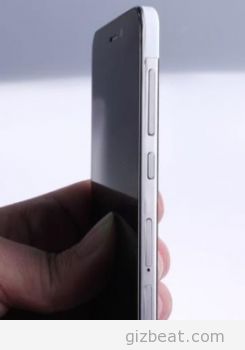 In the ongoing war to have the “world’s thinnest phone”, companies are often reporting the very edge thickness as opposed to the true thickness of the phone. The trend is towards thinner and lighter. Doogee is claiming a 5.5mm profile on their upcoming MT6582 Doogee Turbo DG2014, while it’s very clear that the phone is only 5.5mm at the very edge and thickens considerably in the middle. iNew V3 did the same thing, showing 6.5mm in the official specs, while it’s actually 8mm at the middle.
In the ongoing war to have the “world’s thinnest phone”, companies are often reporting the very edge thickness as opposed to the true thickness of the phone. The trend is towards thinner and lighter. Doogee is claiming a 5.5mm profile on their upcoming MT6582 Doogee Turbo DG2014, while it’s very clear that the phone is only 5.5mm at the very edge and thickens considerably in the middle. iNew V3 did the same thing, showing 6.5mm in the official specs, while it’s actually 8mm at the middle.
This looks very bad for the brand, when claiming something they obviously know not to be the truth. While it could be argued “hey, it’s 6.5, see?”, while measuring the edge, it’s far from the obvious truth and makes them look even dumber for trying to fool us.
In Asia, this is quite common practice. The companies in China aren’t held to the same strict marketing boundries as popular Western brands, thus there’s very little accountability. While this is part of the issue, the other part, is that in Asia – what’s important is ‘face’. Even when everyone knows it’s bull.
What makes the situation even worse is that, at least in the case of the iNew V3, it’s a great product at the right price. There’s certainly no need to claim 6.5mm. By doing so, it creates a backlash. Chinese marketing and customer service has a long, long way to come.
Though they may not realize it yet, this tarnishes their name, to smile and say “look at this red apple”, when it clearly is green. We are now sending Doogee and iNew a healthy digital bitch slap.
On the other side of things. Smartphones simply don’t need to be any thinner. 8mm is thin enough. As they get thinner, they which means there’s less to grip. They also get lighter, in which case durability suffers.
Possibly the most important detrimental effect of the thinnest smartphone war, is the shrinking battery capacity as manufacturers and brands try to squeeze their phones to the thinnest possible profile.
Leave a Reply